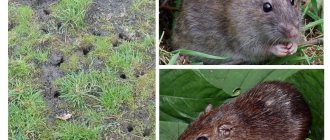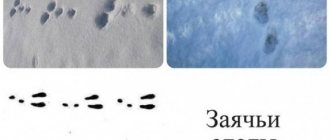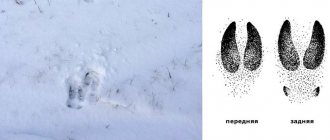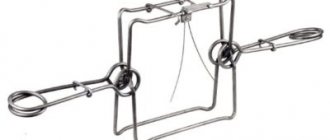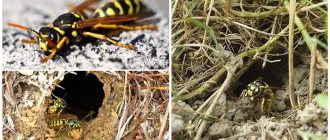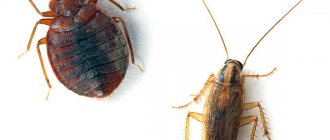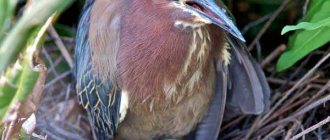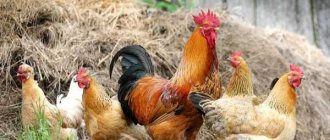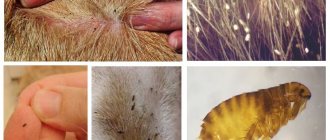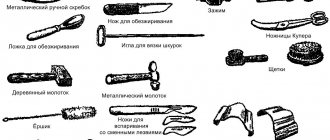As soon as the snow falls and you go wandering through the fresh powder, you will soon come across small lines of these animals. They will stretch and wind for a long time along weeds or ditches, near streams, along the edges of swamps, and will almost certainly be found near stacks of straw darkening on the snow-covered stubble.
The tracks of the weasel and the ermine, the two smallest representatives of mustelids, are very similar both in paw prints and in the nature of their gait. True, an average-sized ermine is noticeably larger than a common weasel, but the difference in size between a small ermine and a large weasel is so insignificant that it is not always possible to say with certainty which of them belongs to the track seen.
Traces of all four paws of a small ermine on drying clay
As always, the clearest prints in winter remain on damp, shallow snow. That's why it can be so interesting to wander through the first powder - even small details of the print are visible in clear traces. It can be seen that in weasels and stoats the imprint of the front foot is somewhat smaller and rounder than the back one. Both tracks have 5 fingerprints. Along the way, let us remember that animals from the cat and canine families only have 4 toes imprinted, since the 1st toe (corresponding to our thumb) is located high on the legs of these animals and does not touch the ground when walking.
The size of the weasel's front paw print is 1.5×1, the back one is 3x1.5 cm. It should, however, be remembered that the weasel most often walks with a two-foot pattern, when the hind paw hits the front paw print and covers it. So the size of each hole left by a pair of paws of the animal will be about 3x2 cm. The paws of an ermine are larger. The front print is 3.3×2, the back is 4.4×2.3 cm.
On loose, loose snow, and in summer on dry sand, the contours of the prints can be blurry, and the footprints themselves appear larger. In addition, the size of the animals themselves varies noticeably.
The length of a weasel's jump at a leisurely pace is about 25 cm. By speeding up the run, the animal makes longer jumps. And in these cases, the jump can almost double in length. The weasel's jumps are light and graceful. Dressed in a winter coat, the white animal is barely visible against the snowy background and seems like an obscure ghost. However, not all of our animals have time to molt before the snowfalls. And vice versa: it happens to see a completely white animal against the background of dark fallen leaves or a cushion of green mosses. In this case, it looks no less ghostly.
From time to time the animal stands on its hind legs in a column and looks around. The same behavior is characteristic of the ermine, although there are still some species differences.
The ermine switches to the three-bead pattern more often than the weasel. With a leisurely searching movement, the length of its jumps ranges from 30 to 40 cm. At higher speeds it can switch to a four-step pattern. With this gait, the jump is rarely shorter than 40 cm. The literature indicates that the longest jump of this animal can reach 1 m, but I have not come across such truly Olympic jumps; apparently, they are rare.
The exploratory movements of these animals are characterized by frequent changes in direction of movement. The trail either goes along the surface, crosses a ditch, jumps out onto the ice of a frozen stream or swamp, or turns towards a group of bushes or a clump of dry grass. Often makes an arc and crosses its own trail. Sometimes it dives under the snow and does not appear on the surface for quite a long time. This is especially true for the little weasel, which moves a lot through the burrows and snow passages of rodents.
From the behavior of these predators, one can feel that they are busy with their usual business, looking for voles and mice - their main prey. However, traces of the hunts themselves are very difficult to find. After all, the final stage of the hunt, its denouement, most often occurs under snow, coastal wind, or in a heap of straw or dead wood. Sometimes only the edges of the snow tunnel from which the animal emerged are red with fresh blood, which indicates a successful hunt of the predator.
Not often, but it is possible to stumble upon the trail of a small hunter dragging his prey to some secluded place in order to have breakfast there without interference. Then, on the side of the tracks, the snow is knocked down by the dragging carcass of a rodent. But the remains of the prey of these animals are found even less often. After all, as already mentioned, weasels and stoats usually eat their prey in shelter.
Sometimes you move aside some board or sheet of plywood thrown into a field, and under it are scraps of fur or other remains of rodents. It happens that there or between the grass hummocks you can see piles of bitten feathers of some small bird. So these animals eat not only small rodents for lunch. The stoat also has larger prey, such as grouse birds or wild rabbits.
Systematization of traces of forest inhabitants
To make it easier to decipher the tracks of forest animals, their classification has been made. Thanks to this, it is easier to figure out which animal left a characteristic mark in the snow. For example, representatives of the canine family leave covered prints in one line. The toe pads with claws are clearly visible on the soil or snow.
Animals such as the brown bear and badger leave a characteristic covered footprint with long claws and bare soles, the size of the front paws is smaller than the hind paws.
A badger's footprint is very similar to a bear's, only smaller in size.
The easiest way to understand is that one of the representatives of the mustelid family walked through the snow. Weasel, marten or sable leave a visible trace of short legs.
Large forest cats, for example, a tiger or a lynx, do not have claw marks, and the tracks of different types of hares are such that it is immediately clear that the animal was running away at a skip.
Deer and related ungulates leave hoof prints.
If the footprint is very small, then this means that a small forest animal passed by: a hedgehog, a squirrel, a mouse, a jerboa, and so on.
In squirrel tracks, larger prints appear at the front.
Paired paw and tail prints are left by numerous field mice, which in the forest serve as food for many predators. The rodent squirrel leaves a trapezoidal four-bead trail.
If you can see that an animal with long outstretched fingers has walked along the ground, then this is most likely the path of a hedgehog.
Ermine
Ermine - body length 18-26 cm. In summer the fur is brown, in winter it is pure white. The end of the tail is always black.
- Habitat biotope.
Banks of reservoirs, edges, clearings, edges of swamps. - What does it eat?
Mouse-like rodents, eggs, chicks, carrion. - Ecology of the species.
The lifestyle is sedentary and secretive. They usually hunt at night. Swims well. Rutting from February to July. There are from 2 to 18 cubs in a litter, usually 6–8. The number is subject to sharp fluctuations. Ermine fur is used as finishing fur. The fur quality standard belongs to Russia. The best quality American varieties are comparable only to the ninth quality level of our standard.
Footprints in the snow
In winter it is much easier to see and decipher tracks than in summer. The white blanket shows prints of almost all forest inhabitants, and not only mammals. If there was no snowfall, then they are very distinct. These tracks usually lead in one of three directions: to the feeding area, to the daytime area, or to the animal’s burrow.
The trail may unexpectedly end near a tree, which means that an animal or bird has climbed a fir tree or birch tree. The specialist immediately determines whether the walker is a predator or a herbivore, an adult or a baby. Some biologists can even distinguish between the paw prints of a female and a male, a sick and a healthy animal.
To correctly determine whether a trace belongs to a specific representative of the forest fauna, you should know the habits, diet and rest regime of the inhabitants of the taiga or mixed forest, as well as the influence of weather on its life activity.
Weasel
Weasel - The smallest representative of mustelids. Body length up to 20 cm. In summer, the fur is brownish-brown, the underside is white. In winter the fur is completely white.
- Habitat biotope.
Various types of forests, field edges, near housing. - What does it eat?
Mouse-like rodents, birds, insects. - Ecology of the species.
The lifestyle is twilight-nocturnal. Actively uses the burrows of mouse-like rodents to search for prey and as a refuge. Moves easily in thick snow. The hunting area is no more than 10 hectares, the daily movement is up to 3 km. When there is an excess of food, it makes reserves - they have found pantries with 100 or more killed rodents. Under favorable conditions, there are 2 broods per year, with 3 to 12 cubs in a litter
Detailed description
Scientists analyzed the footprints of various forest animals. Now every tracker will be able to distinguish by description who owns this or that trail.
• The wolf is a gray forest predator. In summer it is very difficult to see its tracks, but in winter it travels vast distances in search of food. It moves within a pack or alone to find and catch deer, roe deer, elk, hare or other herbivores. Wolves prefer to follow their old paths. The print of this secretive predator resembles that of a dog. But an experienced hunter can easily recognize a wolf's footprint by its larger size and protruding pair of middle fingers. When moving, the wolf places its back right paw in the footprint of its front left paw.
The front toes of a wolf are more forward and are separated from the hind toes by the width of a match, while in dogs, the toes are gathered together and such a gap is no longer observed
• In winter, the bear sleeps in a den. He does not leave his winter house and dreams sweet dreams. But, awakened by the noise of gunfire, he sometimes wakes up and becomes a connecting rod. Therefore, if you manage to see a footprint in the snow that is distinguished by a clubfoot, you should immediately leave the forest.
The winter wandering bear kills everyone who gets in his way. This large forest animal received its nickname “clubfoot” precisely because of its clubfoot. Bear claws are clearly visible on the rounded print of the front paws, and the print of the hind paws is somewhat similar to a human print, only larger. A bear's footprint can be up to twenty centimeters in diameter and cannot be confused with any other trace.
In the print of the bear's front paw, the pads of the fingers are clearly visible, the outlines of the footprint look neat
• The fox is a beautiful forest predator with a red coat. She loves to mouse in the mornings and evenings, and relax on her bed during the day. But if it’s cold, then she goes out to hunt, leaving behind a long line of prints in the snow. The fox track is similar to the dog track, but slimmer and smaller.
The fox's footprint resembles boats - the imprints of an elongated paw with tightly clenched toes.
• It is impossible to see a hare's track in summer. But in winter, the scythe wanders not only through the forest, but also visits villages to eat the bark of fruit trees and harm people. Hares run in jumps, throwing their hind legs forward and their front legs one after the other in succession. If the trail is found in the thicket of the forest, it means that a white squirrel has run across it. And if found in a clearing, meadow or forest-steppe, then these are most likely the paw prints of a hare. Both types of hares have small prints on the back and larger prints on the front.
The tracks of a hare are different from those of a white hare
• In the forest, in the field, in the meadows you can see footprints similar to those of a cow. But no one grazes livestock there, and therefore these are traces of the elk - the handsome forest elk. It leaves very deep marks that look like trenches. Males always have larger tracks than females. This ungulate leaves an image of hooves on a blanket of snow with two large toes in front and two small ones slightly above.
Moose tracks are similar to those of other ungulates, but are significantly larger in size.
• The furry sable lives primarily in the Siberian taiga. If a fisherman sees the tracks of an animal that jumps up to half a meter in length and leaves a double trace of a rounded shape and large size without visible fingertips, then he begins to track the animal or chases it with a husky.
On loose snow, paired sable prints most often merge into one hole
• The lynx is a wild forest cat that hunts primarily for hares. The tracks of this animal with very amazing ears are similar to those of a cat, only larger in size, reaching eight by eleven centimeters in length and width. The lynx loves to move along its old paths along streams, forest edges, and the bed of a taiga river.
It is nocturnal, and if it snows during the day, its tracks may be hidden under freshly fallen powder. In addition, the predator itself is very secretive and rarely catches the eye. Thus, forest dwellers move not only through their native forest, but can also leave traces on the edge of the forest, on the river bank, near the village, and even in the village itself.
The traces of some animals can be discerned by any passerby, but deciphering the paw prints of individual forest inhabitants is only possible by obtaining theoretical knowledge of zoology.
Ideal conditions for night hunting
Natural poultry lovers often visit chicken coops in the winter, especially if the human property borders forest or dense planting. In this case, the smell of the poultry house and fresh prey attracts the animal irresistibly.
Once in the chicken coop, the ferret kills the chickens, stocking up. Knowing about his habits, it is easy to guess that after a couple of night visits there will be nothing left of the feathered population. The predator can make the first attack without victims, only for reconnaissance, but on the second visit there will be a massacre in the chicken coop.
Preventing predators from entering
The best preventive measure is to repair an existing chicken coop or build a new one. In the event that the weasel has become a frequent guest, a new structure will have to be erected.
When carrying out repair work, you need to pay attention to a number of factors:
- eliminating all cracks and holes, even the smallest ones;
- replacing rotten wood;
- strengthening the floor in the poultry house with tin plates;
- cleaning the area around the chicken coop. All garbage heaps and any piles that could become a refuge for a predator must be removed;
- digging a chain-link mesh around the perimeter of the chicken coop;
- installing a chicken coop on piles.
In addition, you should take care of the concrete floor and high-quality roofing, thereby eliminating the possibility of undermining.
Repellers and folk methods
Those who have already understood how to catch a weasel, but do not set themselves the task of catching an uninvited visitor, can be recommended to pay attention to special devices. These electronic repellers are installed in the chicken coop. They emit low-frequency signals that cause panic among predators and force them to leave the forbidden territory.
Those who do not have the opportunity to purchase such a device can use an alternative option. For such purposes, a regular flashlight equipped with motion sensors is suitable. When an uninvited guest approaches, the device begins to play light and sound signals that scare away the animal.
Our grandmothers smeared the walls of the chicken coop with tar. Despite the fact that this method has long been used by villagers, it is not very effective. This is because the animal can enter the house through the roof. In addition, no one guarantees that the smell of tar can scare off a weasel.
How to get rid of a ferret?
It is simply necessary to repel the pest from the poultry house. To do this, they use both old-fashioned methods and modern technologies. Most often, to get rid of a furry predator, they use:
- tar;
- skins;
- trap;
- trap;
- electronic repeller.
Traditional methods
Old-fashioned methods for daring a ferret or weasel include the use of tar. They smeared the outer walls of the poultry house with it. It is believed that the animal cannot stand the smell of this substance. At the same time, they carefully checked the condition of the ventilation in the attic and covered it with a fine grille.
As a natural “drive away” of a hungry predator, lamb, sheep or sheep skins were hung on the walls of the chicken coop. The specific smell of the material was supposed to reliably protect the livestock from overnight guests.
Trap
One of the radical ways to get rid of an insolent ferret is a trap. Having walked around the territory of the poultry house and found holes or tunnels there that the night guest used, you need to stock up on several traps.
Ferrets are the only animals that are not afraid of humans.
In this case, the tools get rid of human odor by boiling in pine water for 25-30 minutes. Then coated with lime. Further, to ensure that the animal does not smell anything, they are additionally treated with manure or chicken droppings.
Traps are placed at the beginning and end of the hole. Having opened the tools, place the bait in the center. You can touch the trap after processing pine needles only with gloves.
DIY trap
For humane ferret or weasel hunters, you can make your own trap. In this case, they take a box that is larger in size than the animal. They lift it and lean it on a stick, which, when the prey gets inside, would fall and slam the box shut. They put bait in the trap: a piece of fresh chicken or fish and wait.
Often farmers make some kind of cage with a door that lowers when an animal gets inside. After which the caught predator is taken far from home and released into the wild.
Modern technologies for repelling pests
For those who do not want to bother with constructing a cage or killing ferrets, weasels and other predatory animals, electronic repellers have been created. The devices emit ultrasound at a certain purity, which is constantly changing and does not allow furry thieves to get used to it and adapt to it.
In addition to poultry, ferrets and martens love to feast on raw eggs. The range of action of such “know-how” is 1.2 thousand square km. Some devices are also equipped with a red beacon, which, like sound, is activated when an animal approaches and stops it. The technique does not affect domestic animals or livestock in any way.
